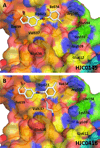Discovery of potent anticancer agent HJC0416, an orally bioavailable small molecule inhibitor of signal transducer and activator of transcription 3 (STAT3)
- PMID: 24904966
- PMCID: PMC4096847
- DOI: 10.1016/j.ejmech.2014.05.049
Discovery of potent anticancer agent HJC0416, an orally bioavailable small molecule inhibitor of signal transducer and activator of transcription 3 (STAT3)
Abstract
In a continuing effort to develop orally bioavailable small-molecule STAT3 inhibitors as potential therapeutic agents for human cancer, a series of novel diversified analogues based on our identified lead compound HJC0149 (1) (5-chloro-N-(1,1-dioxo-1H-1λ(6)-benzo[b]thiophen-6-yl)-2-hydroxybenzamide, Eur. J. Med. Chem. 2013, 62, 498-507) have been rationally designed, synthesized, and pharmacologically evaluated. Molecular docking studies and biological characterization supported our earlier findings that the O-alkylamino-tethered side chain on the hydroxyl group is an effective and essential structural determinant for improving biological activities and druglike properties of these molecules. Compounds with such modifications exhibited potent antiproliferative effects against breast and pancreatic cancer cell lines with IC50 values from low micromolar to nanomolar range. Among them, the newly discovered STAT3 inhibitor 12 (HJC0416) displayed an intriguing anticancer profile both in vitro and in vivo (i.p. & p.o.). More importantly, HJC0416 is an orally bioavailable anticancer agent as a promising candidate for further development.
Keywords: Anticancer agents; Breast cancer; Oral bioavailability; Pancreatic cancer; STAT3 inhibitors.
Copyright © 2014 Elsevier Masson SAS. All rights reserved.
Figures








References
-
- Darnell JE., Jr STATs and gene regulation. Science. 1997;277:1630–1635. - PubMed
-
- Bowman T, Garcia R, Turkson J, Jove R. STATs in oncogenesis. Oncogene. 2000;19:2474–2488. - PubMed
-
- Bromberg J, Darnell JE., Jr The role of STATs in transcriptional control and their impact on cellular function. Oncogene. 2000;19:2468–2473. - PubMed
-
- Turkson J, Jove R. STAT proteins: novel molecular targets for cancer drug discovery. Oncogene. 2000;19:6613–6626. - PubMed
Publication types
MeSH terms
Substances
Grants and funding
LinkOut - more resources
Full Text Sources
Other Literature Sources
Miscellaneous

